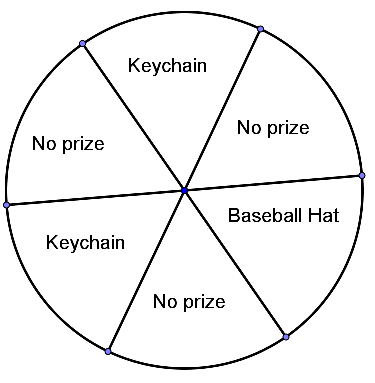Hints will display for most wrong answers; explanations for most right answers. You can attempt a question multiple times; it will only be scored correct if you get it right the first time.
I used the official objectives and sample test to construct these questions, but cannot promise that they accurately reflect what’s on the real test. Some of the sample questions were more convoluted than I could bear to write. See terms of use. See the MTEL Practice Test main page to view questions on a particular topic or to download paper practice tests.
MTEL General Curriculum Mathematics Practice
Question 1 |
How many lines of reflective symmetry and how many centers of rotational symmetry does the parallelogram depicted below have?

4 lines of reflective symmetry, 1 center of rotational symmetry.Hint: Try cutting out a shape like this one from paper, and fold where you think the lines of reflective symmetry are (or put a mirror there). Do things line up as you thought they would? | |
2 lines of reflective symmetry, 1 center of rotational symmetry.Hint: Try cutting out a shape like this one from paper, and fold where you think the lines of reflective symmetry are (or put a mirror there). Do things line up as you thought they would? | |
0 lines of reflective symmetry, 1 center of rotational symmetry.Hint: The intersection of the diagonals is a center of rotational symmetry. There are no lines of reflective symmetry, although many people get confused about this fact (best to play with hands on examples to get a feel). Just fyi, the letter S also has rotational, but not reflective symmetry, and it's one that kids often write backwards. | |
2 lines of reflective symmetry, 0 centers of rotational symmetry.Hint: Try cutting out a shape like this one from paper. Trace onto another sheet of paper. See if there's a way to rotate the cut out shape (less than a complete turn) so that it fits within the outlines again. |
Question 2 |
Use the expression below to answer the question that follows.
\( \large 3\times {{10}^{4}}+2.2\times {{10}^{2}}\)
Which of the following is closest to the expression above?
Five millionHint: Pay attention to the exponents. Adding 3 and 2 doesn't work because they have different place values. | |
Fifty thousandHint: Pay attention to the exponents. Adding 3 and 2 doesn't work because they have different place values. | |
Three millionHint: Don't add the exponents. | |
Thirty thousandHint: \( 3\times {{10}^{4}} = 30,000;\) the other term is much smaller and doesn't change the estimate. |
Question 3 |
Which of the following is equivalent to \( \dfrac{3}{4}-\dfrac{1}{8}+\dfrac{2}{8}\times \dfrac{1}{2}?\)
\( \large \dfrac{7}{16}\) Hint: Multiplication comes before addition and subtraction in the order of operations. | |
\( \large \dfrac{1}{2}\) Hint: Addition and subtraction are of equal priority in the order of operations -- do them left to right. | |
\( \large \dfrac{3}{4}\) Hint: \( \dfrac{3}{4}-\dfrac{1}{8}+\dfrac{2}{8}\times \dfrac{1}{2}\)=\( \dfrac{3}{4}-\dfrac{1}{8}+\dfrac{1}{8}\)=\( \dfrac{3}{4}+-\dfrac{1}{8}+\dfrac{1}{8}\)=\( \dfrac{3}{4}\) | |
\( \large \dfrac{3}{16}\) Hint: Multiplication comes before addition and subtraction in the order of operations. |
Question 4 |
The following story situations model \( 12\div 3\):
I) Jack has 12 cookies, which he wants to share equally between himself and two friends. How many cookies does each person get?
II) Trent has 12 cookies, which he wants to put into bags of 3 cookies each. How many bags can he make?
III) Cicely has $12. Cookies cost $3 each. How many cookies can she buy?
Which of these questions illustrate the same model of division, either partitive (partioning) or measurement (quotative)?
I and II | |
I and III | |
II and IIIHint: Problem I is partitive (or partitioning or sharing) -- we put 12 objects into 3 groups. Problems II and III are quotative (or measurement) -- we put 12 objects in groups of 3. | |
All three problems model the same meaning of division |
Question 5 |
The Venn Diagram below gives data on the number of seniors, athletes, and vegetarians in the student body at a college:

How many students at the college are seniors who are not vegetarians?
\( \large 137\) Hint: Doesn't include the senior athletes who are not vegetarians. | |
\( \large 167\) | |
\( \large 197\) Hint: That's all seniors, including vegetarians. | |
\( \large 279\) Hint: Includes all athletes who are not vegetarians, some of whom are not seniors. |
Question 6 |
The "houses" below are made of toothpicks and gum drops.

Which of the following does not represent the number of gumdrops in a row of h houses?
\( \large 2+3h\) Hint: Think of this as start with 2 gumdrops on the left wall, and then add 3 gumdrops for each house. | |
\( \large 5+3(h-1)\) Hint: Think of this as start with one house, and then add 3 gumdrops for each of the other h-1 houses. | |
\( \large h+(h+1)+(h+1)\) Hint: Look at the gumdrops in 3 rows: h gumdrops for the "rooftops," h+1 for the tops of the vertical walls, and h+1 for the floors. | |
\( \large 5+3h\) Hint: This one is not a correct equation (which makes it the correct answer!). Compare to choice A. One of them has to be wrong, as they differ by 3. |
Question 7 |
A teacher has a list of all the countries in the world and their populations in March 2012. She is going to have her students use technology to compute the mean and median of the numbers on the list. Which of the following statements is true?
The teacher can be sure that the mean and median will be the same without doing any computation.Hint: Does this make sense? How likely is it that the mean and median of any large data set will be the same? | |
The teacher can be sure that the mean is bigger than the median without doing any computation.Hint: This is a skewed distribution, and very large countries like China and India contribute huge numbers to the mean, but are counted the same as small countries like Luxembourg in the median (the same thing happens w/data on salaries, where a few very high income people tilt the mean -- that's why such data is usually reported as medians). | |
The teacher can be sure that the median is bigger than the mean without doing any computation.Hint: Think about a set of numbers like 1, 2, 3, 4, 10,000 -- how do the mean/median compare? How might that relate to countries of the world? | |
There is no way for the teacher to know the relative size of the mean and median without computing them.Hint: Knowing the shape of the distribution of populations does give us enough info to know the relative size of the mean and median, even without computing them. |
Question 8 |
In January 2011, the national debt was about 14 trillion dollars and the US population was about 300 million people. Someone reading these figures estimated that the national debt was about $5,000 per person. Which of these statements best describes the reasonableness of this estimate?
It is too low by a factor of 10Hint: 14 trillion \( \approx 15 \times {{10}^{12}} \) and 300 million \( \approx 3 \times {{10}^{8}}\), so the true answer is about \( 5 \times {{10}^{4}} \) or $50,000. | |
It is too low by a factor of 100 | |
It is too high by a factor of 10 | |
It is too high by a factor of 100 |
Question 9 |
Which property is not shared by all rhombi?
4 congruent sidesHint: The most common definition of a rhombus is a quadrilateral with 4 congruent sides. | |
A center of rotational symmetryHint: The diagonal of a rhombus separates it into two congruent isosceles triangles. The center of this line is a center of 180 degree rotational symmetry that switches the triangles. | |
4 congruent anglesHint: Unless the rhombus is a square, it does not have 4 congruent angles. | |
2 sets of parallel sidesHint: All rhombi are parallelograms. |
Question 10 |
The polygon depicted below is drawn on dot paper, with the dots spaced 1 unit apart. What is the perimeter of the polygon?

\( \large 18+\sqrt{2} \text{ units}\) Hint: Be careful with the Pythagorean Theorem. | |
\( \large 18+2\sqrt{2}\text{ units}\) Hint: There are 13 horizontal or vertical 1 unit segments. The longer diagonal is the hypotenuse of a 3-4-5 right triangle, so its length is 5 units. The shorter diagonal is the hypotenuse of a 45-45-90 right triangle with side 2, so its hypotenuse has length \(2 \sqrt{2}\). | |
\( \large 18 \text{ units}
\) Hint: Use the Pythagorean Theorem to find the lengths of the diagonal segments. | |
\( \large 20 \text{ units}\) Hint: Use the Pythagorean Theorem to find the lengths of the diagonal segments. |
Question 11 |
Taxicab fares in Boston (Spring 2012) are $2.60 for the first \(\dfrac{1}{7}\) of a mile or less and $0.40 for each \(\dfrac{1}{7}\) of a mile after that.
Let d represent the distance a passenger travels in miles (with \(d>\dfrac{1}{7}\)). Which of the following expressions represents the total fare?
\( \large \$2.60+\$0.40d\) Hint: It's 40 cents for 1/7 of a mile, not per mile. | |
\( \large \$2.60+\$0.40\dfrac{d}{7}\) Hint: According to this equation, going 7 miles would cost $3; does that make sense? | |
\( \large \$2.20+\$2.80d\) Hint: You can think of the fare as $2.20 to enter the cab, and then $0.40 for each 1/7 of a mile, including the first 1/7 of a mile (or $2.80 per mile).
Alternatively, you pay $2.60 for the first 1/7 of a mile, and then $2.80 per mile for d-1/7 miles. The total is 2.60+2.80(d-1/7) = 2.60+ 2.80d -.40 = 2.20+2.80d. | |
\( \large \$2.60+\$2.80d\) Hint: Don't count the first 1/7 of a mile twice. |
Question 12 |
Which of the lists below is in order from least to greatest value?
\( \large \dfrac{1}{2},\quad \dfrac{1}{3},\quad \dfrac{1}{4},\quad \dfrac{1}{5}\) Hint: This is ordered from greatest to least. | |
\( \large \dfrac{1}{3},\quad \dfrac{2}{7},\quad \dfrac{3}{8},\quad \dfrac{4}{11}\) Hint: 1/3 = 2/6 is bigger than 2/7. | |
\( \large \dfrac{1}{4},\quad \dfrac{2}{5},\quad \dfrac{2}{3},\quad \dfrac{4}{5}\) Hint: One way to look at this: 1/4 and 2/5 are both less than 1/2, and 2/3 and 4/5 are both greater than 1/2. 1/4 is 25% and 2/5 is 40%, so 2/5 is greater. The distance from 2/3 to 1 is 1/3 and from 4/5 to 1 is 1/5, and 1/5 is less than 1/3, so 4/5 is bigger. | |
\( \large \dfrac{7}{8},\quad \dfrac{6}{7},\quad \dfrac{5}{6},\quad \dfrac{4}{5}\) Hint: This is in order from greatest to least. |
Question 13 |
A car is traveling at 60 miles per hour. Which of the expressions below could be used to compute how many feet the car travels in 1 second? Note that 1 mile = 5,280 feet.
\( \large 60\dfrac{\text{miles}}{\text{hour}}\cdot 5280\dfrac{\text{feet}}{\text{mile}}\cdot 60\dfrac{\text{minutes}}{\text{hour}}\cdot 60\dfrac{\text{seconds}}{\text{minute}}
\) Hint: This answer is not in feet/second. | |
\( \large 60\dfrac{\text{miles}}{\text{hour}}\cdot 5280\dfrac{\text{feet}}{\text{mile}}\cdot \dfrac{1}{60}\dfrac{\text{hour}}{\text{minutes}}\cdot \dfrac{1}{60}\dfrac{\text{minute}}{\text{seconds}}
\) Hint: This is the only choice where the answer is in feet per second and the unit conversions are correct. | |
\( \large 60\dfrac{\text{miles}}{\text{hour}}\cdot \dfrac{1}{5280}\dfrac{\text{foot}}{\text{miles}}\cdot 60\dfrac{\text{hours}}{\text{minute}}\cdot \dfrac{1}{60}\dfrac{\text{minute}}{\text{seconds}}\) Hint: Are there really 60 hours in a minute? | |
\( \large 60\dfrac{\text{miles}}{\text{hour}}\cdot \dfrac{1}{5280}\dfrac{\text{mile}}{\text{feet}}\cdot 60\dfrac{\text{minutes}}{\text{hour}}\cdot \dfrac{1}{60}\dfrac{\text{minute}}{\text{seconds}}\) Hint: This answer is not in feet/second. |
Question 14 |
The prime factorization of n can be written as n=pqr, where p, q, and r are distinct prime numbers. How many factors does n have, including 1 and itself?
\( \large3\) Hint: 1, p, q, r, and pqr are already 5, so this isn't enough. You might try plugging in p=2, q=3, and r=5 to help with this problem. | |
\( \large5\) Hint: Don't forget pq, etc. You might try plugging in p=2, q=3, and r=5 to help with this problem. | |
\( \large6\) Hint: You might try plugging in p=2, q=3, and r=5 to help with this problem. | |
\( \large8\) Hint: 1, p, q, r, pq, pr, qr, pqr. |
Question 15 |
Which of the lines depicted below is a graph of \( \large y=2x-5\)?

aHint: The slope of line a is negative. | |
bHint: Wrong slope and wrong intercept. | |
cHint: The intercept of line c is positive. | |
dHint: Slope is 2 -- for every increase of 1 in x, y increases by 2. Intercept is -5 -- the point (0,-5) is on the line. |
Question 16 |
Which of the following nets will not fold into a cube?
 Hint: If you have trouble visualizing, cut them out and fold (during the test, you can tear paper to approximate). | |
 | |
 Hint: If you have trouble visualizing, cut them out and fold (during the test, you can tear paper to approximate). | |
 Hint: If you have trouble visualizing, cut them out and fold (during the test, you can tear paper to approximate). |
Question 17 |
At a school fundraising event, people can buy a ticket to spin a spinner like the one below. The region that the spinner lands in tells which, if any, prize the person wins.

If 240 people buy tickets to spin the spinner, what is the best estimate of the number of keychains that will be given away?
40Hint: "Keychain" appears on the spinner twice. | |
80Hint: The probability of getting a keychain is 1/3, and so about 1/3 of the time the spinner will win. | |
100Hint: What is the probability of winning a keychain? | |
120Hint: That would be the answer for getting any prize, not a keychain specifically. |
Question 18 |
Which of the following is equivalent to
\( \large A-B+C\div D\times E\)?
\( \large A-B-\dfrac{C}{DE}
\) Hint: In the order of operations, multiplication and division have the same priority, so do them left to right; same with addition and subtraction. | |
\( \large A-B+\dfrac{CE}{D}\) Hint: In practice, you're better off using parentheses than writing an expression like the one in the question. The PEMDAS acronym that many people memorize is misleading. Multiplication and division have equal priority and are done left to right. They have higher priority than addition and subtraction. Addition and subtraction also have equal priority and are done left to right. | |
\( \large \dfrac{AE-BE+CE}{D}\) Hint: Use order of operations, don't just compute left to right. | |
\( \large A-B+\dfrac{C}{DE}\) Hint: In the order of operations, multiplication and division have the same priority, so do them left to right |
Question 19 |
A biology class requires a lab fee, which is a whole number of dollars, and the same amount for all students. On Monday the instructor collected $70 in fees, on Tuesday she collected $126, and on Wednesday she collected $266. What is the largest possible amount the fee could be?
$2Hint: A possible fee, but not the largest possible fee. Check the other choices to see which are factors of all three numbers. | |
$7Hint: A possible fee, but not the largest possible fee. Check the other choices to see which are factors of all three numbers. | |
$14Hint: This is the greatest common factor of 70, 126, and 266. | |
$70Hint: Not a factor of 126 or 266, so couldn't be correct. |
Question 20 |
A map has a scale of 3 inches = 100 miles. Cities A and B are 753 miles apart. Let d be the distance between the two cities on the map. Which of the following is not correct?
\( \large \dfrac{3}{100}=\dfrac{d}{753}\) Hint: Units on both side are inches/mile, and both numerators and denominators correspond -- this one is correct. | |
\( \large \dfrac{3}{100}=\dfrac{753}{d}\) Hint: Unit on the left is inches per mile, and on the right is miles per inch. The proportion is set up incorrectly (which is what we wanted). Another strategy is to notice that one of A or B has to be the answer because they cannot both be correct proportions. Then check that cross multiplying on A gives part D, so B is the one that is different from the other 3. | |
\( \large \dfrac{3}{d}=\dfrac{100}{753}\) Hint: Unitless on each side, as inches cancel on the left and miles on the right. Numerators correspond to the map, and denominators to the real life distances -- this one is correct. | |
\( \large 100d=3\cdot 753\) Hint: This is equivalent to part A. |
|
List |
If you found a mistake or have comments on a particular question, please contact me (please copy and paste at least part of the question into the form, as the numbers change depending on how quizzes are displayed). General comments can be left here.